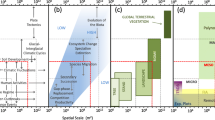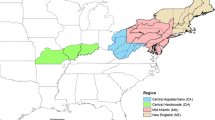Abstract
Three gap models, KOPIDE, NEWCOP, and ForClim, were compared with respect to their structure and behavior at four sites along an elevational gradient on Changbai Mt., northeastern China, under current climate and six climate change scenarios. This study intends to compare the three gap models under identical conditions, using a standardized simulation protocol. The three models were originally developed with different backgrounds and for different purposes. While they are relatively similar in the level of structural detail they include, they still differ in many respects regarding the assumptions that are made for representing specific ecological processes.The simulations showed that none of the three gap models provides satisfactory results in all situations; each gap model has strong and weak points in its behavior. While all models are fairly successful in simulating the composition of dominant species along the gradient under current climatic conditions, their projections under a set of hypothetical scenarios of climatic change diverge rather strongly. The analysis of these simulation results shows that several problem areas need to be addressed before any of the models can be used for a reliable impact assessment.Recommendations for improvements of the models are made, including the formulation of temperature and drought effects on tree establishment and tree growth, the size of the species pool, the appropriate choice of patch size and disturbance regimes, and allometric relationships. When aiming to use gap models under new environmental conditions, we propose to carefully reconsider their formulations based on our knowledge of the relevant processes in the region under concern, instead of using the models in an `as-is' mode.
Similar content being viewed by others
References
Badeck, F.-W., Lischke, H., Bugmann, H., Hickler, T., Hönninger, K., Lasch, P., Lexer, M.J., Mouillot, F., Schaber, J., and Smith, B.: 2001, ‘Tree Species Composition in European Pristine Forests. Comparison of Stand Data to Model Predictions’, Clim. Change 51, 307–347.
Botkin, D. B.: 1993, Forest Dynamics: An Ecological Model, Oxford University Press, New York.
Bugmann, H.: 1994, On the Ecology of Mountainous Forests in a Changing Climate: A simulation Study, Ph.D. Thesis No. 10638, Swiss Federal Institute of Technology Zürich, Switzerland, 258 pp.
Bugmann, H.: 1996, ‘A Simplified Forest Model to Study Species Composition Along Climate Gradients’, Ecology 77, 2055–2074.
Bugmann, H.: 1997a, ‘Sensitivity of Forests in the European Alps to Future Climatic Change’, Clim. Res. 8, 35–44.
Bugmann, H.: 1997b ‘Gap Models, Forest Dynamics and the Response of Vegetation to Climate Change’, in Huntley, B., Cramer, W., Morgan, A. V., Prentice, H.C., and Allen, J. R. M. (eds.), Past and Future Rapid Environmental Changes: The Spatial and Evolutionary Responses of Terrestrial Biota, Springer-Verlag, 441–453.
Bugmann, H.: 1999, ‘Anthropogene Klimaveränderung, Sukzessionsprozesse und Forstwirtschaftliche Optionen’, Schweiz. Z. Forstwes. 150, 275–287.
Bugmann, H.: 2001, ‘A Review of Forest Gap Models’, Clim. Change 51, 259–305.
Bugmann, H. and Cramer, W.: 1998, ‘Improving the Behaviour of Forest GapModels Along Drought Gradients’, Forest Ecol. Manage. 103, 247–263.
Bugmann, H. and Solomon, A. M.: 1995, ‘The Use of a European Forest Model in North America: A Study of Ecosystem Response to Climate Gradients’, J. Biogeogr. 22, 477–484.
Bugmann, H. and Solomon, A. M.: 2000, ‘Explaining Forest Biomass and Species Composition Across Multiple Biogeographical Regions’, Ecol. Appl. 10, 95–114.
Bugmann, H., Yan, X., Sykes, M. T., Martin, Ph., Lindner, M., Desanker, P. V., and Cumming, S. G.: 1996, ‘A Comparison of Forest Gap Models: Model Structure and Behaviour’, Clim. Change 34, 231–237.
Horn, H. S.: 1975, ‘Forest Succession’, Sci. Am. 232, 90–98.
Keane, R. E., Austin, M., Field, C., Huth, A., Lexer, M. J., Peters, D., Solomon, A. and Wyckoff, P.: 2001, ‘Tree Mortality in Gap Models: Application to Climate Change’, Clim. Change 51, 509–540.
Li, W., Li, F., and Han, J.: 1981, ‘Study on Biomass and Primary Production of Main Ecosystems in Changbai Mountain’, Research of Forest Ecosystems 2, 34-50 (in Chinese).
Lindner, M., Bugmann, H., Lasch, P., Flechsig, M., and Cramer, W.: 1997, ‘Regional Impacts of Climatic Change on Forests in the State of Brandenburg, Germany’, Agr. For. Met. 84, 123–135.
Loehle, C. and LeBlanc, D.: 1996, ‘Model-Based Assessments of Climate Effects on Forests: A Critical Review’, Ecol. Modelling, 90, 1–31.
Manabe, J. F. B. and Wetherald, R. T.: 1987, ‘Large Scale Changes in Soil Wetness Induced by an Increase in Carbon Dioxide’, J. Atmos. Sci., 44, 1211–1235.
Martin, P.: 1992, ‘EXE: A Climatically Sensitive Model to Study Climate Change and CO2 Enrichment Effects on Forests’, Austr. J. Bot. 40, 717–735.
Miles, J., French, D. D., and Xu, Z.: 1983, ‘A Preliminary Study of the Successional Status of a Stand of Mixed Broadleaved/Pinus Koraiensis Forest in Changbai Mountain, Northeastern China’.,Research of Forest Ecosystems 3, 54–72 (in Chinese).
Norby, R. J., Ogle, K., Curtis, P. S., Badeck, F.-W., Huth, A., Hurtt, G. C., Kohyama, T., and Peñuelas, J.: 2001, ‘Aboveground Growth and Competition in Forest Gap Models: An Analysis for Studies of Climatic Change’, Clim. Change 51, 415–447.
Pitelka, L. F., Bugmann, H., and Reynolds, J. F.: 2001, ‘How Much Physiology is Needed in Forest Gap Models for Simulating Long-Term Vegetation Response to Global Change? Introduction’, Clim. Change 51, 251–257.
Pitman, A. J. and Henderson-Sellers, A.: 1998, ‘Recent Progress and Results from the Project for the Intercomparison of Landsurface Parameterization Schemes’, Journal of Hydrology, 213, 128–135.
Price, D. T., Zimmermann, N. E., van der Meer, P. J., Lexer, M. J., Leadley, P., Jorritsma, I. T. M., Schaber, J., Clark, D. F., Lasch, P., McNulty, S., Wu, J., and Smith, B.: 2001, ‘Regeneration in Gap Models: Priority Issues for Studying Forest Responses to Global Change’, Clim. Change 51, 475–508.
Shao, G.: 1989, KOPIDE: A Computer Model of Forest Growth and Succession on Changbai Mountain, Ph.D. Dissertation. Chinese Academy of Sciences.
Shao, G.: 1996, ‘Potential Impacts of Climate Change on a Mixed Broadleaved-Korean Pine Forest Stand: A Gap Model Approach’, Clim. Change 34, 263–268.
Shao, G., Schall, P. and Weishampel, J. F.: 1994, ‘Dynamic Simulations of Mixed Broadleaved-Pinus koraiensis Forests in the Changbaishan Biosphere Reserve of China’, Forest Ecol. Manage. 70, 169–181.
Shao, G., Shugart, H. H., and Bugmann, H. S.: 2001, ‘Suggestions for Biometrical Improvements in Forest Gap Models’, Journal of Mathematical Modelling and Scientific Computing (in press).
Shao, G., Shugart, H. H., and Smith, T. M.: 1995, ‘A Role-Type Model (Rope) and Its Application in Assessing Climate Change Impacts on Forest Landscapes’, Vegetatio 121, 135–146.
Shao, G., Zhao, S., and Shugart, H. H.: 1996, Forest Dynamics Modeling: Preliminary Explanations of Optimizing Management of Korean Pine Forests. 170 pp. China Forestry Publishing House (in Chinese).
Shugart, H. H.: 1984, A Theory of Forest Dynamics, Springer, New York.
Shugart, H. H.: 1998, Terrestrial Ecosystems in Changing Environments, Cambridge University Press, New York.
Shugart, H. H., Emanuel, W. R., and Shao, G.: 1996, ‘Models of Forest Structure for Conditions of Climate Change’, Commonwealth Forestry Review 75, 51–64.
Solomon, A.M.: 1986, ‘Transient Response of Forests to CO2-Induced Climate Change: Simulation Modeling Experiments in Eastern North America’, Oecologia, 68, 567–579.
Thornthwaite, C. W. and Mather, J. R.: 1957, ‘Instructions and Tables for Computing Potential Evapotranspiration and the Water Balance’, Publications in Climatology. Lab. Climatol., 10, 185–311.
Wullschleger, S. D., Jackson, R. B., Currie, W. S., Friend, A. D., Luo, Y., Mouillot, F., Pan, Y. and Shao, G.: 2001, ‘Below-Ground Processes in Gap Models for Simulating Forest Response to Global Change’, Clim. Change 51, 449–473.
Xu, Z.: 1992, ‘Periodic Review of Forest Ecosystem Researched at Changbai Mountain: 1979–1985’, Research of Forest Ecosystems, 6, 25–42.
Yan, X. and Zhao, S.: 1996, ‘Simulating Chanbai Mt. Forests with Climate Change’, J. Environ. Sci. 8, 358–368 (in Chinese).
Yan, X., Zhao, S., Shugart, H. H., Fu, C., and Yu, Z.: 1999, ‘How Should the Xiao Hinggan Mt. Forests Change with Potential Climate Change: A Simulation Study’, J. Nat. Res. 14, 372–376 (in Chinese).
Zhao, S., Yan, X., Tao, D., Yang, S., and Dai, L.: 1995, ‘Some Advance in Studies on Responses of Northeastern China Forests to Possible Climate Change’, Chinese Journal of Ecology 15(Supp. B), 1–11 (in Chinese).
Zhao, S., Yan, X., Yang, S., Tao, D., and Dai, L.: 1998, ‘Simulating Responses of Northeastern China Forests to Potential Climate Change’, J. Forest. Res. 9, 166–172.
Author information
Authors and Affiliations
Rights and permissions
About this article
Cite this article
Shao, G., Bugmann, H. & Yan, X. A Comparative Analysis of the Structure and Behavior of Three Gap Models at Sites in Northeastern China. Climatic Change 51, 389–413 (2001). https://doi.org/10.1023/A:1012550300768
Issue Date:
DOI: https://doi.org/10.1023/A:1012550300768




